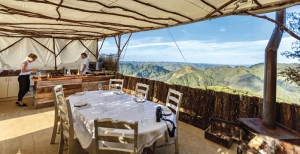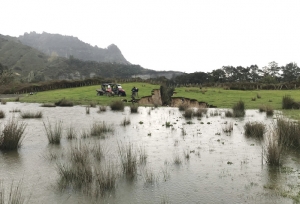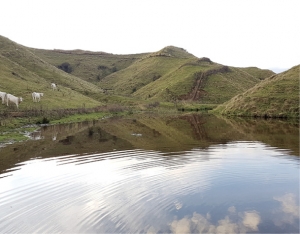Super User
Planting day at Wairio
A planting day for Victoria University students and Ducks Unlimited members at Wairio came with a few more mod cons than usual, thanks to DU President Ross Cottle.
He arrived in his motorhome with Big Red, the side-by-side in tow, which meant hot cups of tea and sausages for lunch and the easy delivery via SxS of the plants to the planting site.
There was a good turnout as students from Victoria University’s School of Biological Sciences led by Stephen Hartley, director, Greater Wellington Regional Council and DOC representatives, DU members and others all chipped to help with the day’s work.
About 300 specimen trees – kahikatea, tōtara, swamp maire and cabbage trees – were bought with a $2000 grant from the Department of Conservation.
Many hands make light work, and by the end of the day, the trees were in place as in-fill in Stage 3 of the wetland, the university’s “classroom in a wetland”, among the nursery trees planted five years ago.
GIVEAWAY
Flight magazine has a copy of The Forest for the Trees, a book by Wayne Bennett, of Forest Flora, to give away.
Wayne says his book explains the benefit of observing natural areas carefully and using this knowledge as a template for restoring forests and wetlands.
He is the co-ordinator for Ecosourced Waikato, a project manager for Waikato Rivercare and is on the committee of Ngaruawahia Action Group.
“Our native plants vary across the country and there is value in retaining this natural diversity.
“If we are to ensure we only plant species that cope well with the conditions and want to minimise weed incursions, we can learn so much from observing what remnants we have left of natural areas,” Wayne says.
“I may be known to some DU members through the taxidermy work I did through the 1980s, 90s and 2000s. I have been restoring forests and wetlands for nearly 40 years and learn best from my mistakes. The book does not gloss over mistakes but takes lessons from them.”
He says there are many books on the identification of native plants but few describing how they grow, what they tolerate and what they are vulnerable to.
“These are things that usually only experience can tell but there is a section discussing the ecology of all of the plants mentioned elsewhere in the book, both native plants and weeds.
“There are many native plants, not well known, that contribute to the welfare of waterfowl. This book is intended to help provide that knowledge.”
You can access a copy online at: www.forestflora.co.nz/Forest_for_trees.html for free but for those who like to have a copy to hold and take with you, hard copies are available from This email address is being protected from spambots. You need JavaScript enabled to view it. for $45 including GST postage and packaging. An invoice will be emailed out once the book has been sent.
To go into the draw to win a copy, email the Flight editor at This email address is being protected from spambots. You need JavaScript enabled to view it. with “Forest for the trees” in the subject line and provide your name and address in the email
Whio exceed target in Fiordland
The Department of Conservation has high hopes for the upcoming whio breeding season in Fiordland. About 64 breeding whio were found earlier this year in a survey of a security site for the blue ducks.
Senior ranger Andrew (Max) Smart says this means the northern Fiordland site is the first in the South Island to exceed the target of 50 breeding pairs.
“Security sites are the highest priority whio conservation areas in the country; there are four in the North Island and four in the South Island.
"The target of 50 breeding pairs is set for each security site through the Whio Recovery Plan. A couple of sites on the North Island have reached this target, but we’re the first confirmed site on the South Island to do so.”
Whio have come a long way since 1999/2000 when only three pairs were found in this security site, Max says. “This year’s number is only a minimum and there could be up to another nine pairs.
“Extended trapping efforts and landscape scale predator control have enabled the whio here, and at key sites around New Zealand, to make a strong comeback.”
Whio are monitored using walk-through river surveys using specially trained conservation dogs. Two surveys a year are planned for each river.
The first survey, in November and December, counts the number of ducklings, as well the number of individual birds and pairs seen. The second survey, generally in January and February, counts the number of fledglings.
Exceeding this target is great news for whio, but according to Max, there is still a lot of work to do to secure a future for this species.
“We are only doing work over a relatively small area and this is where we are making a difference. Predator control has to be kept up and expanded for whio to have a chance to increase in number and spread over their natural range.”
Fish deaths call for relocation project rethink
When more than 900 brown mudfish in the Wairarapa were transferred to a new wetlands habitat to make way for wastewater storage reservoirs, the district council initially claimed it was a success, but it was later learnt that most of the fish did not survive.
Fish & Game reported that the project in December and January involving 921 mudfish, organised by Carterton District Council, had resulted in virtually none surviving.
In July Greater Wellington Regional Council told the Wairarapa Times-Age that it would undertake further monitoring of the translocated population and would be tracking how the mudfish and their habitat were doing.
“Our immediate focus is on creating additional habitat that we believe will be more suitable for brown mudfish,” it said. “Once we are happy that this new habitat is established, we will relocate the remaining mudfish.”
GWRC believed mudfish were still present in the wetland where they were relocated, but in lower numbers.
“Unfortunately, the habitat created did not develop as we had hoped, in particular in relation to the aquatic vegetation cover that would have provided cover for the mudfish.
“High water temperatures and predation by birds, such as shags and herons, are considered to be among some of the key issues that impacted on the success of the translocation.”
GWRC will continue to work closely with the district council to create a new habitat more similar to the original area the fish were relocated from.
“We will be incorporating the learnings so far to ensure that the project has the best chance of success, in terms of maintaining and enhancing brown mudfish habitat.”
The project will now be led by Alton Perrie, an environmental scientist from GWRC who has “considerable expertise in mudfish”.
Fish & Game Wellington manager Phil Teal has called for an independent inquiry by the Department of Conservation into the transfer.
A Fish & Game senior scientist even advised the project co-ordinators last year that this project was not advisable.
“This is $160,000 of ratepayers’ money that would be much better used on meaningful conservation projects that would benefit all fish habitat,” he said.
Versatile mudfish underrated
Most New Zealanders are unaware of the existence of this little known but special species of fish, let alone seen one. If you were to cross an eel with a whitebait – this is what the Canterbury mudfish looks like.
Small, tubular and lacking scales, the adults are 10 to 12cm long, generally nocturnal and are restricted to small isolated freshwater locations, so are seldom seen. The juveniles feed during the day, hiding at night to avoid being eaten by their adult counterparts.
Mudfish may appear unspectacular, but they have some very special characteristics and they are part of our treasured taonga.
To allow them to survive in periods of drought, mudfish bury themselves in damp surroundings such as under logs, tree roots or vegetation to wait for surface water to return. By slowing down their metabolic rate and breathing oxygen through their skin, mudfish can survive up to two months out of water!
There are five species of mudfish and all are classified as either threatened or at risk under the New Zealand Threat Classification with the most threatened being the Canterbury mudfish.
At the Isaac Conservation and Wildlife Trust in Christchurch, a focus to increase numbers of Canterbury mudfish is being achieved by optimising their pond environment to promote their establishment, removing predator fish species such as eels, trout and salmon and working closely with DOC to monitor and study this endangered species.
A threat to all species of mudfish across New Zealand is the depletion of habitat by the draining of swamps, wetlands and the modification of waterways and drains through mechanical clearance.
Simple mudfish habitat protection can be achieved through:
- Fencing off the wetland from stock to prevent wetland plants being grazed and trampled.
- Plant a native vegetation buffer and DOC can recommend suitable plants for riparian planting.
- Prevent invasive fish species establishing by finding out which species are in your catchment and taking care not to accidentally introduce them.
- Maintain drains and waterways using mudfish friendly methods. Create shade on the margins to minimise growth of freshwater weeds. If physical weed removal is required, clear short sections at a time.
The benefits of wetland protection and expansion are advantageous also for native bird and invertebrate species, allowing them to flourish and multiply for future generations.
Catherine Ott is the administration manager for the Isaac Conservation Land Wildlife Trust.
‘The biggest conservation project on Earth’
Dan Steele, the man with the gavel at the yearly DU auctions, headed to Wellington the week after the AGM to play to a different kind of crowd – at Homewood, the home of the British high commissioner, as part of Wellington on a Plate, the city’s month-long celebration of good food.
Dan and UK chef Jack Cashmore teamed up to offer guests a 10-course degustation menu, finishing the meal with a discussion by Dan on conservation, sustainability and a better New Zealand.
Dan said in an interview after the event: “New Zealand could be the biggest conservation project on Earth.
“For me, the big picture is that New Zealand could lead the world in producing quality products which world-class chefs, like Jack Cashmore, want to use in the best restaurants in the world. We can also lead in the realm of biodiversity management and conservation.
“It’s a big ask to get the primary industries on board to work closely together, but if we can pull it off and be recognised as the biggest conservation project on Earth at the same time as continuing to farm, then every product in New Zealand will become more valuable,” he said.
Sharing in his philosophy is Jack, who has worked in two Michelin-starred restaurants and was head chef at Anglo in London. Since meeting almost 10 years ago, Jack and Dan have shared a vision for both the farm and New Zealand.
Their goal is for Blue Duck Station and its pop-up restaurant, The Chef’s Table at Blue Duck Station, which was open last summer, to be the best overnight and fine-dining experience in New Zealand – based on the philosophy of nature conservation and sustainability.
Jack said it was New Zealand’s array of biodiversity, open culture, and sense of community that kept him coming back. Now his second home, Blue Duck Station offers him the chance to build a small restaurant from scratch.
You win some, you lose some
In 2012 a wetland was created at DU Director Dan Steele’s property, Blue Duck Station in the Ruapehu district, but things haven’t gone exactly as planned. Water has tunnelled under the pumice layer – the hills are predominantly pumice – to the next hard layer, first creating an underground leak, which DU’s John and Gail Cheyne noticed during a visit.
Next came the washout: Dan says, “We first noticed pumice floating down the Retaruke River before we found the washout.”
As of publication date, the problem is still waiting for a solution.
Meantime Dan has not been idle but had to climb out of his gumboots for a day or two to head to the city, see The biggest conservation project on Earth.
A strong supporter
Ducks Unlimited wishes to record the passing of Jonathan Williams Preston, 90, of Raetihi, at the end of last year.
Jon was generous with his support of DU and had enjoyed seeing the land that he previously owned being transformed by Graeme Berry and Paddy Chambers who bought it in 2004.
Jon was also a member of the Wanganui Vintage Car Club for almost 50 years and the owner of some interesting and historic vehicles. He will be missed.
The evolution of Courtney’s Close
On a parcel of land at Mangaone in Raetihi, in an area that was once an unproductive, narrow, boggy drain bound by strong ridges, co-owners Graeme Berry and Paddy Chambers saw a potential habitat for waterfowl.
DU Patron Di Pritt says, “Since Graeme and Paddy Chambers have been involved at Mangaone, from 2004, they have created six major wetland areas – ranging from an acre to 10 acres – which are all fenced and they have planted about 38 acres. Another four major ponds have also been created.
“It is an amazing achievement, and was fully supported by the previous owner, Jon Preston.”
Their latest project is Courtney’s Close, a wetland area they named after the Horizons employee who helped with the project.
They created it by splitting a 300-acre paddock in half and building a 650-metre deer fence. The wetland area now consists of four ponds outside the fence, and three, with room for two more, enclosed by the fence.
This means animals have access to water but are excluded from the lower wetlands and impurities are filtered out along the way.
Inside the fences Graeme and his partner, Bang, have planted natives, protected from the deer.
A marvellous way to see Hauraki Gulf
One of this year’s auction items was a two-night fishing trip in the Hauraki Gulf for four people. Kees Weytmans has been there, done that, so here’s what this year’s winners can expect.
At the 2018 conference auction in Hamilton, John and Diny Dermer and Kees and Kay Weytmans won the two-night fishing trip in the Hauraki Gulf on Brian and Wendy Simmons’ 40-foot launch.
It was an all expenses paid trip; food (breakfast, lunch and dinner), private cabins, wine, beer and all the fishing gear.
Late February 2019 was the date that suited everyone and so on a Friday afternoon, we were welcomed on to the launch.
Now, I have done many things in my life (some of which have not been done by many others...) but I never been on a “boat” this size – just MARVELLOUS!
Brian and Wendy were the most hospitable hosts you could have wished for. The conversation was lively, always interesting. We came well prepared with Sea-Legs tablets but we didn’t need them. The beer and wine flowed freely and the Drambuie was on tap. Wendy can make really nice meals in a reasonably small place and we ate well.
Brian, with his all encompassing knowledge about the landscape, scenery, history and who owns which boat and which bach was an ever-entertaining host.
We visited Governor George Grey’s mansion as well as an old copper mine.
The fishing was excellent in that we caught many, many fish. And that’s what’s it about – the thrill of the catch. Unfortunately we had put most of them back due to size. But there was plenty for the next morning’s breakfast.
We like to thank Brian and Wendy for them being most generous. We had a wonderful time with them.
And Kay and I would like to express our best wishes for a speedy recovery for Brian after his fall. Only at the last conference, did we hear about his accident. We wish him well.
This year the Weytmans and the Dermers won an auction for a night at Blue Duck Lodge.








